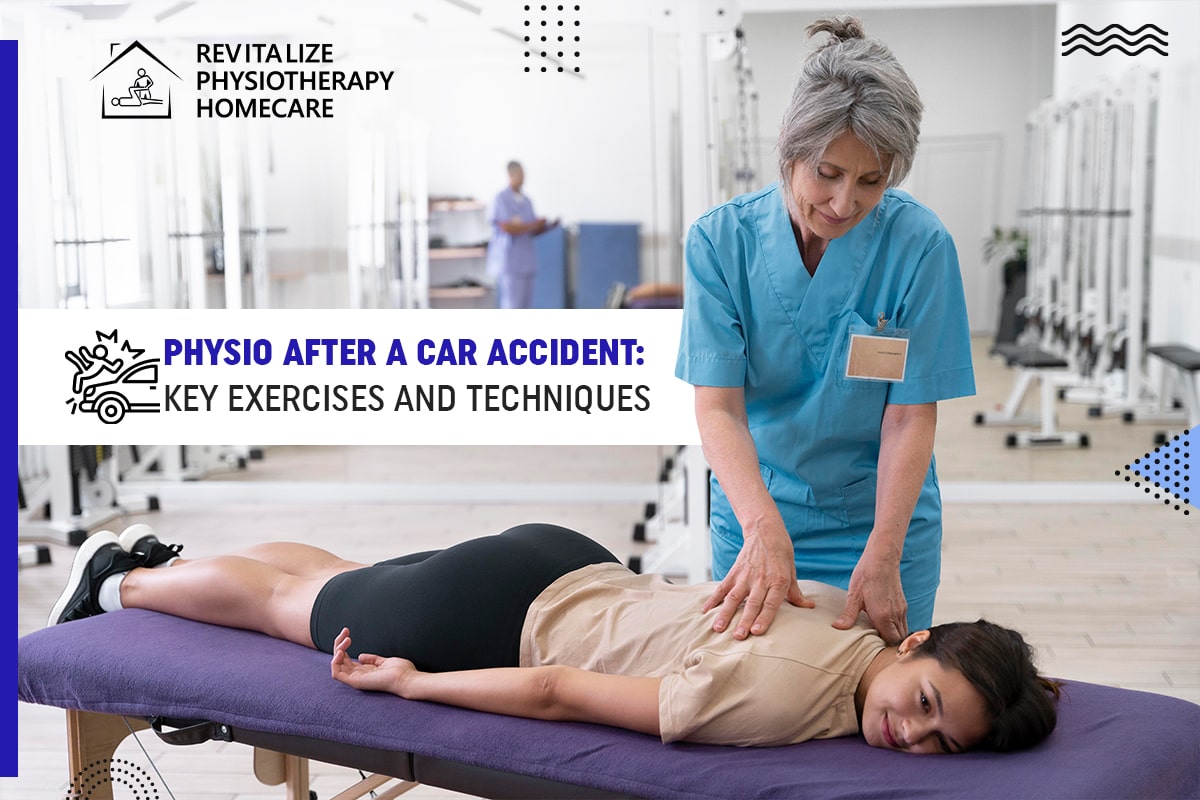Physio After a Car Accident: Key Exercises and Techniques
Car accidents can be life-altering, causing both physical and emotional trauma. Among the most common physical injuries are whiplash, back pain, and muscle strains. Physiotherapy plays a crucial role in recovery, helping you regain strength, mobility, and reduce pain.
In this blog, we will explore key exercises and techniques used in physiotherapy after a car accident. These exercises are designed to be simple and easy to follow, but always consult with a healthcare professional before starting any new exercise routine.
Understanding the Importance of Physiotherapy
Physiotherapy is a treatment method that focuses on restoring, maintaining, and maximizing physical function and movement. After a car accident, physiotherapy can help in:
- Pain Management: Reducing pain through targeted exercises and techniques.
- Improving Mobility: Restoring movement and flexibility.
- Strengthening Muscles: Building strength in injured or weakened areas.
- Preventing Long-term Damage: Avoiding chronic pain and permanent injuries.
Key Exercises and Techniques of Physio After a Car Accident
1. Neck Stretches and Exercises
Neck injuries, such as whiplash, are common after car accidents. Gentle neck stretches and exercises can help alleviate pain and improve mobility.
Neck Rotation:
- Sit or stand raised, shoulders relaxed.
- Slowly turn your head to the right, attempting to see behind your shoulder.
- Hold the position for 5 seconds, feeling a gentle stretch in the muscles on the side of your neck.
- Return your head to the center and then turn to the left, holding for another 5 seconds.
- Repeat this rotation 10 times on each side, aiming to increase your range of motion over time.
Chin Tucks:
- Sit or stand up straight, shoulders relaxed.
- Slowly tuck your chin towards your chest, creating a double chin without straining.
- Hold this position for 5 seconds, feeling the stretch at the back of your neck.
- Relax and repeat the movement 10 times. This exercise helps strengthen the muscles at the front of your neck and improve posture.
2. Shoulder and Upper Back Exercises
Shoulder pain and upper back stiffness are also common after an accident. These exercises can help:
Shoulder Shrugs:
- Place your feet shoulder-width apart and your arms at your sides as you stand.
- Lift your shoulders upwards towards your ears in a shrugging motion.
- Hold the position for 5 seconds, feeling the tension in your shoulders.
- Release and drop your shoulders gradually.
- Repeat this movement 10 times, focusing on a controlled motion to avoid additional strain.
Shoulder Blade Squeezes:
- Either stand up or adopt a straight seat with your arms at your sides.
- As though you were attempting to grasp a pencil between your shoulder blades, squeeze them together.
- Hold this position for 5 seconds, feeling the contraction in your upper back muscles.
- Relax and repeat 10 times. This exercise strengthens the muscles that run between your shoulder blades and helps with posture.
3. Lower Back Exercises
Following auto accidents, complaints of lower back pain are common. Strengthening the lower back and core muscles is essential for recovery.
Pelvic Tilts:
- Lying on your back, place your feet flat on the floor and bend your knees.
- Tilt your pelvis upward, contract your abdominal muscles, and press your lower back flat on the floor.
- Hold this position for 5 seconds, feeling the engagement of your core muscles.
- Relax and repeat 10 times. This exercise helps improve lower back stability and reduce pain.
Bridges:
- Lying on your back, place your feet flat on the floor and bend your knees.
- Squeeze your glutes at the top of the movement by pressing your feet into the floor and lifting your hips towards the ceiling.
- Hold this position for 5 seconds, feeling the stretch in your hip flexors and the strength in your glutes and lower back.
- Slowly lower your hips back to the floor and repeat 10 times.This workout tones the hamstrings, glutes, and lower back.
4. Leg and Hip Exercises
Leg and hip exercises are important for overall mobility and strength, especially if you've experienced leg injuries.
Straight Leg Raises:
- With one leg bent and the other straight, lie on your back.
- Tighten your abdominal muscles and lift the straight leg to the height of the bent knee.
- Hold this position for 5 seconds, feeling the engagement in your thigh and hip muscles.
- Slowly lower the leg back down and repeat 10 times on each leg. The hip flexors and quadriceps are strengthened by this workout.
Hip Flexor Stretch:
- Make a 90-degree angle at both knees by bending forward with the opposite foot.
- Push your hips forward until you feel a stretch in the front of your hip on the side of the kneeling leg.
- Hold this stretch for 20 seconds, keeping your upper body upright and stable.
- Repeat three repetitions on each side after switching sides. This stretch helps relieve tension in the hip flexors and improve hip mobility.
5. Gentle Aerobic Exercises
Aerobic exercises can help improve cardiovascular health and increase overall energy levels. Start with low-impact activities and gradually increase intensity as you recover.
Walking:
- Begin with short walks, starting with 5-10 minutes and gradually increasing the duration.
- Aim to walk for 20-30 minutes, 3-5 times a week. Walking is a gentle way to improve circulation, reduce stiffness, and enhance overall fitness.
Swimming:
- Swimming is a low-impact exercise that is easy on the joints and helps build cardiovascular endurance.
- Try swimming laps at a comfortable pace or participating in water aerobics classes. The buoyancy of the water supports your body and reduces stress on your injuries.
Techniques for Pain Relief and Relaxation
In addition to exercises, certain techniques can help manage pain and promote relaxation.
Heat and Cold Therapy:
- Use a heating pad or warm towel on sore areas for 15-20 minutes to relax muscles and improve blood flow.
- Apply an ice pack wrapped in a towel to reduce swelling and numb pain for 10-15 minutes. Alternate between heat and cold as needed to manage pain and inflammation.
Massage Therapy:
- A light massage can ease tense muscles, increase blood flow, and encourage calm.
- Consider seeing a professional massage therapist who specializes in injury recovery. They can provide targeted treatments to address specific areas of pain and stiffness.
Deep Breathing and Relaxation Techniques:
- Deep breathing techniques might help you relax and cope with stress.
- Take a comfortable seat or lie down, close your mouth and gently release the air as you inhale deeply through your nose. Try to release any tension in your body by concentrating on your breathing.
- Repeat this deep breathing exercise for 5-10 minutes daily to help manage pain and improve overall well-being.
Conclusion
Recovering from a car accident can be a challenging journey, but with the right Physio After a Car Accident, you can improve your physical health and well-being. Remember to consult with a healthcare professional before starting any new exercise routine, and listen to your body’s signals. With consistent effort and patience, you can regain strength, mobility, and live a pain-free life.
Revitalize Physiotherapy and Homecare offers personalized rehabilitation programs customized to your specific needs. Our team of experienced physiotherapists provides in-home services, ensuring you receive the best care in the comfort of your home. From initial assessment to ongoing treatment, we support your recovery journey every step of the way, helping you regain your independence and quality of life. Reach out to us at 905-452-0222 or mail at revitalizephysio@gmail.com today to start your path to recovery.




